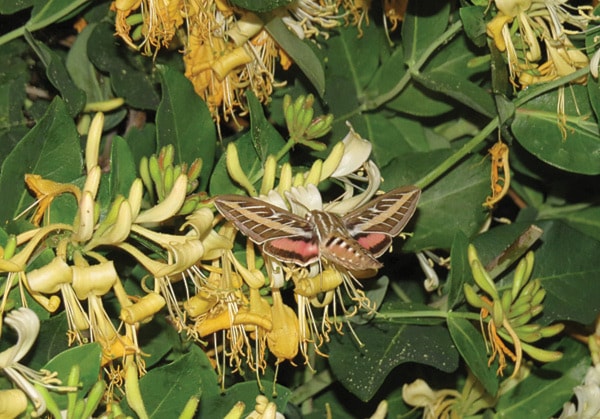Convergent evolution is the process by which unrelated animals come to resemble one another by independently evolving similar traits.
This comes about as the result of adapting to similar environments and/or ecological niches. The wings of birds and bats are one example while the streamlined body shape (with fins) of the shark and porpoises are another example.
Here in the Okanagan we have a remarkable example of convergent evolution in a group of moths called hummingbird moths (also called hawk moths or sphinx moths) and actual hummingbirds.
Although the former is an insect and the latter a bird, they are remarkably similar in many ways because they occupy the same (or very closely similar) ecological niche — they both obtain food (nectar) from trumpet — shaped flowers.
These flowers generally tend to be fairly fragile (examples are honeysuckle, lobelia and beebalm) so that the creature obtaining nectar from that flower can’t actually land on it, but rather must hover close to it and use an elongated beak or proboscis to obtain the nectar.
So hummingbirds have developed this remarkable ability amongst birds to hover in place for long periods of time; they can fly vertically up or down and even go backwards. They fly up to a flower, hover at the opening and insert their long beak and lap up the nectar with their tongue.
Hummingbird moths (the family Sphingidae) also fly up to the flower and hover in place while they insert their long proboscis into the flower. Unlike hummingbirds however, the moths suck up the nectar much as you would suck lemonade through a straw.
The flight patterns of these moths while feeding is remarkably similar to that of hummingbirds — they have an extremely fast wing-beat so they can hover, fly up or down and also go backwards!
They are so hummingbird-like that quite often they are mistaken for real hummingbirds at first look. They vary in size a great deal but the common one in the Okanagan (White-lined sphinx) is only slightly smaller than our smallest hummingbird, Calliope. This moth has a wing span of six to seven centimetres.
The larva of sphinx moths may be well known to our local gardeners as the tomato hornworm.
Sphinx moths are not confined to North America, there are over 1,000 species throughout the world.
As might be implied by the word “moth” in their name, these tend to feed in the evening around dusk whereas hummingbirds tend to feed in daylight. However, I have seen sphinx moths feeding in the afternoon and I’ve seen hummingbirds at my feeder until just about dark.
I have never seen a sphinx moth at a hummingbird feeder, however. I attribute this to the fact that the moths are first attracted to the flowers by scent rather than sight.
When my honeysuckle was in full bloom the scent was so strong in the evenings that I could easily smell it from 22.86 metres away and on those nights there would be as many as six or seven moths hovering about the flowers.
The hummingbird feeder was less than three metres away but they never went near it.
There are other animals that are nectar feeders and interestingly they too have evolved the ability to hover while feeding from the flowers, these include certain bats and another group of insects, called appropriately, hoverflies.
You have to go at least as far south as southern Arizona in summer to see nectar-feeding bats, but hoverflies occur all over North America as well as on the other continents.
These two groups are also examples of convergent evolution and all four nectar feeders are important pollinators.
Meet with us
The South Okanagan Naturalists’ Club next meets on Sept. 25 at the Penticton United Church on Main St at 7 p.m. The meeting is open to all.
For details on that meeting and other South Okanagan Naturalists’ Club functions check out our website at www.southokanagannature.com.
Bob Handfield is president of the South Okanagan Naturalists’ Club but the views expressed here are his own and not necessarily those of the Club.
